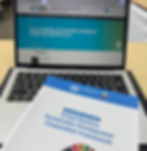Charting Sustainability in the Philippines: Reflections from the Field
- Shannon Gibson
- Jul 22
- 4 min read
Updated: Jul 22
By Dr. Shannon Gibson
Professor of Environmental Studies, International Relations and Political Science
University of Southern California
After a whirlwind four weeks teaching Sustainable Development in the Philippines, I’m still catching my breath—in the best possible way. This summer course, offered through USC’s Faculty Led Programs and housed in the Environmental Studies Program, took 10 incredible students through five cities in the Philippines to explore what sustainable development looks like in practice: the promises, the challenges, and the lived experiences of those working at the intersection of environment, economy, and community.
From the Global to the Local: A Tour of the Philippines
The course was built around five Sustainable Development Goals (SDGs) that form the backbone of the Philippines' national development agenda:

Goal 8: Decent Work and Economic Growth (with a focus on eco-tourism)
Goal 13: Climate Action (Philippines’ role in the Paris Agreement)
Goals 14 & 15: Life Below Water and Life on Land (biodiversity, marine resources, and deforestation)
Goal 17: Partnerships for the Goals (collaboration with the UN and beyond)
Our learning journey began in Manila, where we explored the Philippines’ high-level engagement with the United Nations and the global governance mechanisms shaping SDG progress. We met with representatives from UNDP, UNIDO, and UN Women, who offered insight into national reporting processes, gender mainstreaming, and the unique vulnerabilities faced by the Philippines as an archipelagic nation on the front lines of climate change. I was struck not only by the complexity of these challenges, but by the passion of those dedicating their lives to finding solutions.

From there, we flew to Cebu, where we shifted gears to more localized policy engagement. Partnering with the University of San Carlos, we participated in lectures and field visits with grassroots organizations working on ocean conservation, climate adaptation, and sustainable livelihoods. These conversations brought the global goals down to earth—literally—as we visited natural sites across the city and several NGOs grappling with the daily realities of climate threats.
Next, we boarded a ferry to Bohol, home to the Philippines’ first and only UNESCO Global Geopark. There, we dug into the relationship between conservation and culture, visiting the famous Chocolate Hills, Loboc River and endangered tarsier habitats. We also visited with local environmental government agencies and grassroots organizations to better understand the tightrope walk between preservation and development. Our stay at the Bohol Bee Farm—a working model of sustainable agriculture and agro-tourism—was one of many reminders that “sustainable” can mean smart, vibrant, and deeply rooted in place.
We then traveled to Puerto Princesa, Palawan, where biodiversity takes center stage. Island hopping across Honda Bay and visiting wildlife sanctuaries gave us a firsthand view of the region's ecological richness—and the urgency of its protection. In conversations with local academics and non-profit conservation leaders, we heard about the pressures of tourism, the push to protect Indigenous lands, and the balance of maintaining environmental integrity while supporting local economies.

Finally, we concluded in El Nido, a picturesque eco-tourism hub where development and conservation coexist in an ongoing negotiation. Our time here included island-hopping adventures and meetings with environmental advocates and educators who are actively shaping what a “green economy” might look like in one of the country’s most sought-after destinations. These final days gave students time to reflect, synthesize their learning, and share their own analyses through op-ed blogs, policy memos, and digital storytelling projects.
Teaching and Learning, Side by Side
What made this experience especially meaningful for me—beyond the beauty of the landscapes or the depth of the discussions—was the opportunity to learn alongside such a thoughtful, curious, and compassionate group of students. As a mid-career academic, I came into this course expecting to teach. And I did. But I also found myself growing—both intellectually and personally—every single day. Whether it was a student asking a probing question I hadn’t considered, or a moment of collective awe while kayaking through mangrove forests, I leave this course renewed in my commitment to climate justice and the power of education as a force for global change.

In the weeks ahead, you’ll hear directly from my students, who will be publishing a series of blogs sharing their individual experiences and research. They’ll dive into everything from coastal resilience to climate finance, environmental justice, sustainable ecotourism, and beyond. I can’t wait for you to read their reflections—each one offers a unique window into the challenges and opportunities of sustainable development in the Philippines.
Thank you for following along with our journey. I hope you find this series as insightful, energizing, and hopeful as I did.
